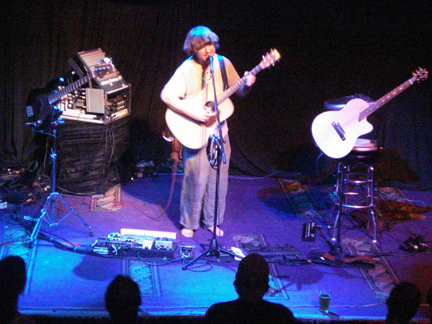
Photo by Glenn BurnSilver
Keller Williams was met with typically unpredictable Alaska weather for the previous evening’s outdoor show in Healy, on the edge of Denali National Park as he was blasted with high winds, rain and a mighty chill in the night air.
One day and 98 miles north in Fairbanks, the proceedings were significantly warmer inside The Blue Loon as Williams was greeting by an up-for-anything crowd, which jived perfectly with Williams’ anything-is-possible performance attitude.
On this night, anything seemed like everything as Williams mixed a varied sampling of originals with a wide range of covers including Stevie Wonder’s “Superstition” segued into the O’Jays “For the Love of Money,” Van Morrison’s “Moondance” (complete with a Zamfir acid-inspired flute solo via effected guitar), the Grateful Dead’s “Fire on the Mountain” (with Williams scatting Jerry Garcia’s classic solo), Carole King’s “(You Make Me Feel Like A) Natural Woman,” some Pink Floyd, Bob Marley and more.
And the crowd of a couple hundred ate it up, the dance floor constantly in motion. Williams’ kinetic performance never allowed time for the floor to clear as each set is like one fluid motion from end to end. Even the batteries dying on his acoustic guitar’s wireless remote isn’t enough to stem to flow, and Williams simply ad-libbed to keep the audience in place while the problem was solved.
Those familiar with Williams’ style know the routine: begin with a guitar, bass or drum lick, loop it, repeat with next instrument, play acoustic guitar and sing over the top while tweaking things here and there with a mixer. In the studio, this type of thing is done all the time, but when considering the thought process required to piece it all together in the live setting, and to see Williams moving seamlessly from instrument station to station to make it work, it is impressive.
What also stands out is the variety of musical styles — a necessary element to this style of performance. After a while it starts to get old watching (and hearing) Williams setting up a song in that move from station to station, even if what he does with it is pretty cool. But the fact that no genre is off-limits keeps the attention level high if for nothing else to see, when it all melds together, where he might go next.
Even with all the covers, none were done spot-on, nor were they intended to be that way. Instead, Williams provided his own touch or quirkiness to everything familiar or otherwise, often building tracks into more techno/rave-oriented jams with pulsing dance beats and grooving rhythms. This direction has become more prevalent in Williams work in recent years, maybe for a reason: it worked well to keep people moving throughout the three-plus hour show.


No Comments comments associated with this post